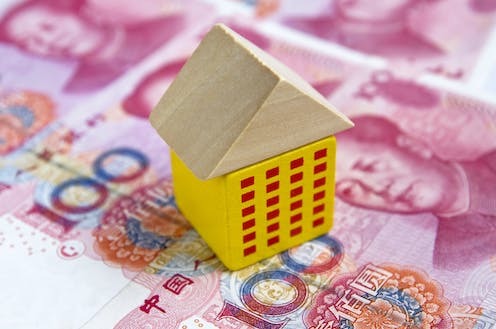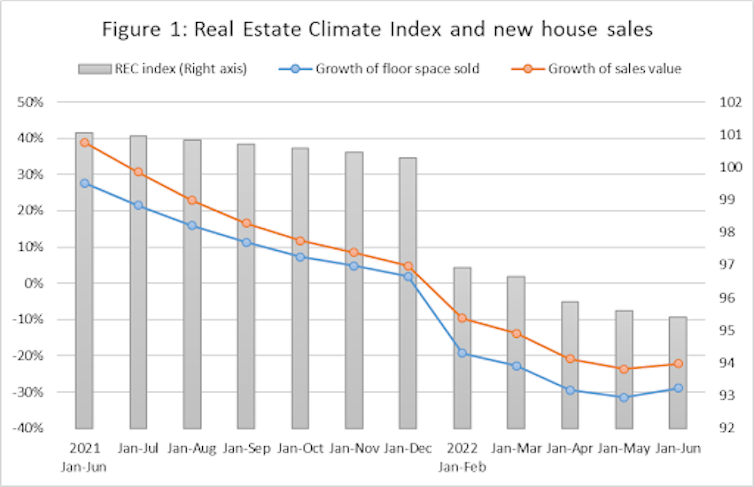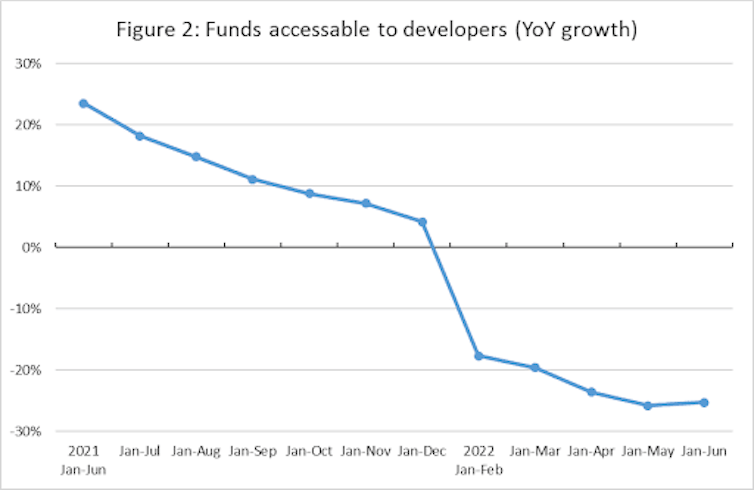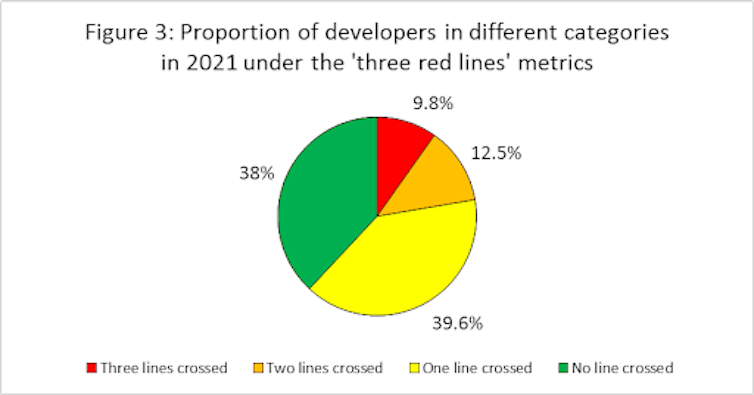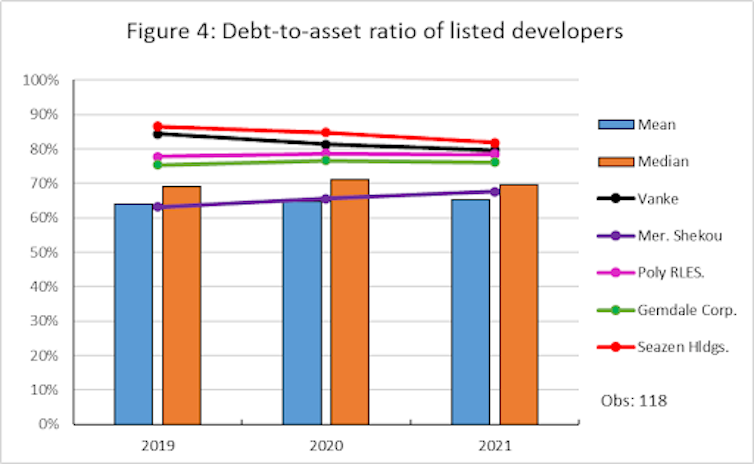China has been trimming interest rates recently – in contrast to other major economies – as it tries to stem the economic effects of its zero-COVID policy and address a growing property crisis. The country’s traditionally strong housing market has been affected by a funding crisis that has seen development paused and led to buyers refusing to pay their mortgages.
The recent spate of mortgage strikes by homebuyers across China has exposed the risk that has accumulated in the market as it has developed over the past two decades. The mortgage strikes started earlier this year among a group of people that bought homes in an Evergrande development in Jingdezhen city, Jiangxi province, but protests have since spread to buyers of other developments throughout China.
To date, more than 300 groups of homeowners are believed to be refusing to pay between US$150 billion (£127 billion) and US$370 billion in homeloans, according to informal surveys published online.
These protesters all have one thing in common: they have been paying mortgages, often at a rate of 5%-6%, on homes they have never lived in. These properties were sold before they were built under what’s called the presale system, which is a common way to buy property in China.
The trigger for the buyers’ strikes is a widespread belief among these protesters that the funds homeowners have paid in advance to the builders of these property developments have been misused.
Under the presale system, buyers deposit money in an account before the property is built. Chinese banks and local authorities are obligated to monitor developers’ use of these funds. Developers are not supposed to have access to all of the money until they have hit certain pre-agreed milestones during the building process.
But buyers have recently complained that many banks –- whether or not local authorities are aware is unclear –- have been providing loans to developers before the required stage of work has been reached.
Buyers have also complained that, although these funds should have been kept in designated escrow accounts that regulators can monitor, sometimes they are not, enabling developers to evade regulations. Overall, these buyers believe loose regulation of funds has provided some developers with both the temptation and ability to keep investing in new projects, by borrowing more before current projects are completed.
Indeed, a commonly observed pattern in China’s property development industry is for developers to purchase lands, pledge them to banks to get loans, start projects, begin the presale process with buyers and then use these funds to purchase lands for other projects.
In such situations, only a portion of a buyer’s funds might go towards the construction of their own property. As a result, a recent liquidity crisis in the sector has stalled many projects because the developers involved can’t afford to continue building.
The rise and fall of the Chinese property market
Today’s situation follows a boom in the Chinese property market. The housing market had been enjoying a long rise since the early 2000s, which reached a peak in 2018 before a gradual cooling that ended in a sharp decline in sales in early 2022.
The chart below (figure 1) shows the change in China’s Real Estate Climate index, which measures aggregate business activity in land sales and real estate. New house sales have slumped substantially this year, with values dropping by 22% compared to the same time last year.
Author's chart based on figures from National Bureau of Statistics of China
The weak market has substantially reduced the funding available to developers, as figure 2 below shows. This is the root cause of the current situation in which developers have paused building, causing homeowners to strike by refusing to pay their mortgages.
Author's chart based on figures from National Bureau of Statistics of China
Tightening credit conditions also play an important role. Among other things, a key policy change is the government’s “three red lines” regulation, introduced in August 2020. It categorises developers according to how much debt they hold, which then determines how much more they can borrow annually.
More than 60% of developers have hit at least one of the debt thresholds set by regulators in 2021, as shown in figure 3 below. Around 10% – crisis-hit Evergrande included – have breached all three. When this happens, developers are not allowed to raise new borrowing for that year. The resulting credit crunch has pushed many developers into a stressed position, with some even defaulting.
Red: no new interest-bearing debt is allowed. Orange: new interest-bearing debt growth must not exceed 5%. Yellow: new interest-bearing debt growth must not exceed 10%. Green: new interest-bearing debt growth must not exceed 15%. Author's chart based on reports from China Real Estate Data Academy.
The wider effects
The potential for a wave of developer bankruptcies is the biggest risk to China’s housing market at the moment and could result in a large number of unfinished properties.
This is not alarmism: Chinese developers generally borrow a lot of money to fund ongoing construction. While the industry average debt-to-asset ratio is around 65%, some of the leading companies are even more indebted (see figure 4 below).
Author's chart based on figures from China Stock Market & Accounting Research (CSMAR) Database.
The industry has also seen a gradual fall in developers’ current ratios (their ability to repay short-term debts, see figure 5 below), which indicates lower overall liquidity and leaves the industry vulnerable to financial shocks.
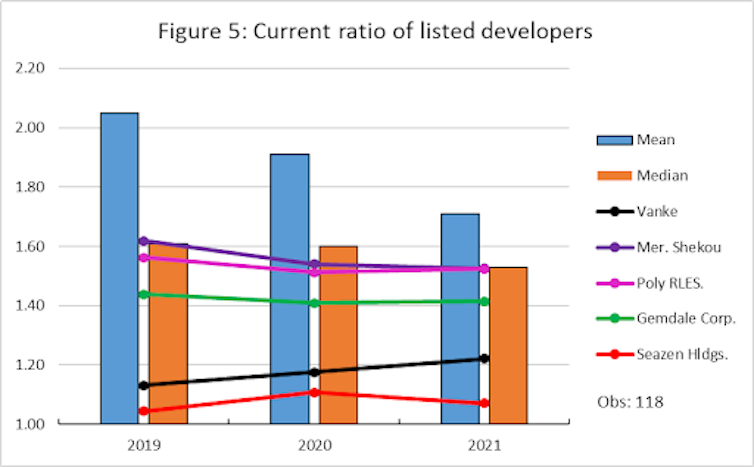
The current ratio is a liquidity measure, calculated by dividing a company’s total current assets by its total current liabilities. A falling ratio indicates less protection from short-term financial problems. Author's chart based on figures from China Stock Market & Accounting Research (CSMAR) Database.
The risk from the real estate sector could also spill into the wider economy via banks and local governments, which are the two biggest entities supporting China’s growth.
Banks lend both to buyers and developers and so could face a surge in bad debts if the housing market collapsed. The good news is that these loans are a relatively small proportion of the banks’ total lending. According to my own calculations based on government figures, mortgage loans comprised just under 20% of banks’ total lending by the end of 2021, while, as declared by the major banks, only about 0.01% of those loans are affected by the current strikes.
On the other hand, real estate developments comprise only 6.2% of Chinese banks’ total loan books. Even so, major defaults could lead banks to tighten lending conditions, causing market liquidity to fall even further.
Local governments are a different story. They often rely heavily on selling land for income and so failing to secure a stable flow of proceeds from land sales could affect their investment and urbanisation projects. This would be a further drag on China’s recovery from the pandemic at a time when it is already struggling due to the government’s ongoing zero-COVID policy.
When it comes to global implications, it’s worth remembering China’s “closed” capital account policy restricts movement of money in and out of the country. This largely isolates China’s financial market from the international market.
So, unlike during the 2007-8 global financial crisis, these defaults would be unlikely to directly affect the world economy, although countries that trade with China may see a modest fall in demand from their Chinese consumers.



 Dollar Slips as Weak U.S. Manufacturing Data Increases Pressure for Fed Rate Cuts
Dollar Slips as Weak U.S. Manufacturing Data Increases Pressure for Fed Rate Cuts  U.S. Cyber Monday Online Sales Surge Past $9.1 Billion as Holiday Shopping Momentum Builds
U.S. Cyber Monday Online Sales Surge Past $9.1 Billion as Holiday Shopping Momentum Builds  South Korea Posts Stronger-Than-Expected 1.3% Economic Growth in Q3
South Korea Posts Stronger-Than-Expected 1.3% Economic Growth in Q3  Oil Prices Rise as Ukraine Targets Russian Energy Infrastructure
Oil Prices Rise as Ukraine Targets Russian Energy Infrastructure  Trump and Lula Discuss Trade, Sanctions, and Security in “Productive” Phone Call
Trump and Lula Discuss Trade, Sanctions, and Security in “Productive” Phone Call  Dollar Slides to Five-Week Low as Asian Stocks Struggle and Markets Bet on Fed Rate Cut
Dollar Slides to Five-Week Low as Asian Stocks Struggle and Markets Bet on Fed Rate Cut  U.S. Soybean Shipments to China Gain Momentum as Trade Tensions Ease
U.S. Soybean Shipments to China Gain Momentum as Trade Tensions Ease  RBA Signals Possible Rate Implications as Inflation Proves More Persistent
RBA Signals Possible Rate Implications as Inflation Proves More Persistent  Japan’s Service Sector Sustains Growth Momentum in November
Japan’s Service Sector Sustains Growth Momentum in November  Asian Markets Stabilize as Wall Street Rebounds and Rate Concerns Ease
Asian Markets Stabilize as Wall Street Rebounds and Rate Concerns Ease  Gold Prices Steady as Markets Await Key U.S. Data and Expected Fed Rate Cut
Gold Prices Steady as Markets Await Key U.S. Data and Expected Fed Rate Cut  China Urged to Prioritize Economy Over Territorial Ambitions, Says Taiwan’s President Lai
China Urged to Prioritize Economy Over Territorial Ambitions, Says Taiwan’s President Lai  Dollar Holds Steady as Markets Shift Focus to 2026 Rate Cut Expectations
Dollar Holds Steady as Markets Shift Focus to 2026 Rate Cut Expectations  U.S. May Withhold $30.4 Million From Minnesota Over Improper Commercial Driver Licenses
U.S. May Withhold $30.4 Million From Minnesota Over Improper Commercial Driver Licenses  U.S. Futures Steady as Rate-Cut Bets Rise on Soft Labor Data
U.S. Futures Steady as Rate-Cut Bets Rise on Soft Labor Data  Asian Currencies Steady as Markets Await Fed Rate Decision; Indian Rupee Hits New Record Low
Asian Currencies Steady as Markets Await Fed Rate Decision; Indian Rupee Hits New Record Low 











